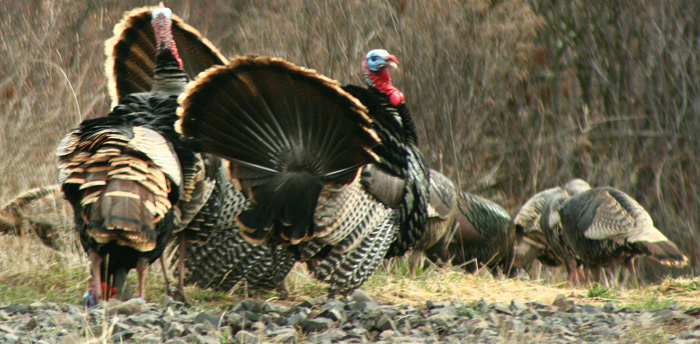 Accepted turkey-hunting lore mostly originates in the East, where hemmed-in woodlots and limited space make wandering taboo. Bowhunting Western turkey is different, wide open space and vast public lands giving bowhunters more elbow room. While Eastern turkeys can pose a complicated game of chess, bowhunting Western birds normally becomes purely physical, require more hiking and climbing than championship calling skills.
Accepted turkey-hunting lore mostly originates in the East, where hemmed-in woodlots and limited space make wandering taboo. Bowhunting Western turkey is different, wide open space and vast public lands giving bowhunters more elbow room. While Eastern turkeys can pose a complicated game of chess, bowhunting Western birds normally becomes purely physical, require more hiking and climbing than championship calling skills.
Run-and-gun turkey hunting can also include quality binoculars, used to gaze across wide meadows, from the lip of a mesa or across mountain canyons seeking ambling gobblers.
A call that grabs gobblers’ attention is equally important. Loud locator calls (screaming peacocks, crow calls, or coyote howlers) can help locate a gobbler in the next zip code or buck Western winds. Actual turkey calls should follow suit. Box calls are perfect for pounding out attention-grabbing yelps, switching to precise slates or diaphragms once a tom draws closer.
Having a bird roosted isn’t necessary (though convenient). Start the morning wandering obvious habitat or travelways. Sound off with a loud locator or box call every so often, glassing when possible but covering ground to increase your odds of finding a hot tom. This approach also facilitates all-day hunting, and doesn’t require time-consuming preseason scouting.
Once a gobbler’s located the fun begins. Remember, though, mountain birds can prove reluctant to alter travel plans. In these cases do what it takes to arrive in a gobbler’s or mixed flock’s path before setting up. This can involve spirited jogs and long climbs in rough country, but is rewarded afterwards with willing birds. Once in position, calling uneducated Western birds is the easy part
Western Turkey Checklist
- Binoculars: Choose a quality, high-objective 8- or 10-power glass that’s steady in the hand yet easy on the neck after a long day on the trail. Glasses with configurations such as 8x32, 8x42, 10x40, or 10x42 are perfect out West.
- Calls: Loud locator calls, such as peacock or crow calls are great for getting a distant bird to sound out when it’s windy. Classic box calls are preferred, because they’re good for producing loud yelps.
- Decoy: Decoys can help pull a gobbler across an open meadow or off a rough ridge.
- Clothing: Keep a set of light rain gear in your pack for unexpected showers or even late snow common in the West. Shaggie outer layers or 3-D outfits help conceal you should you have to set up quickly in a less-than-ideal location.
- Boots: Choose boots with uncompromising ankle support and aggressive soles to keep feet healthy in rough Western terrain.
- Bow Sling: A sling for your compound bow leaves your hands free to use a binocular and calls, and makes it easier to carry over long miles.
- Navigation & Survival Tools: Navigation tools and survival gear should always be included in your Western pack, to keep your way and in case of emergencies.
Any Eastern turkey-hunting snob will be happy to remind you how dumb Western birds are—as if this is a bad thing. These are typically burly fellows who know nothing of how physically challenging a Western turkey hunt can be. Let them have their Eastern birds, we like our dumb birds just fine.






